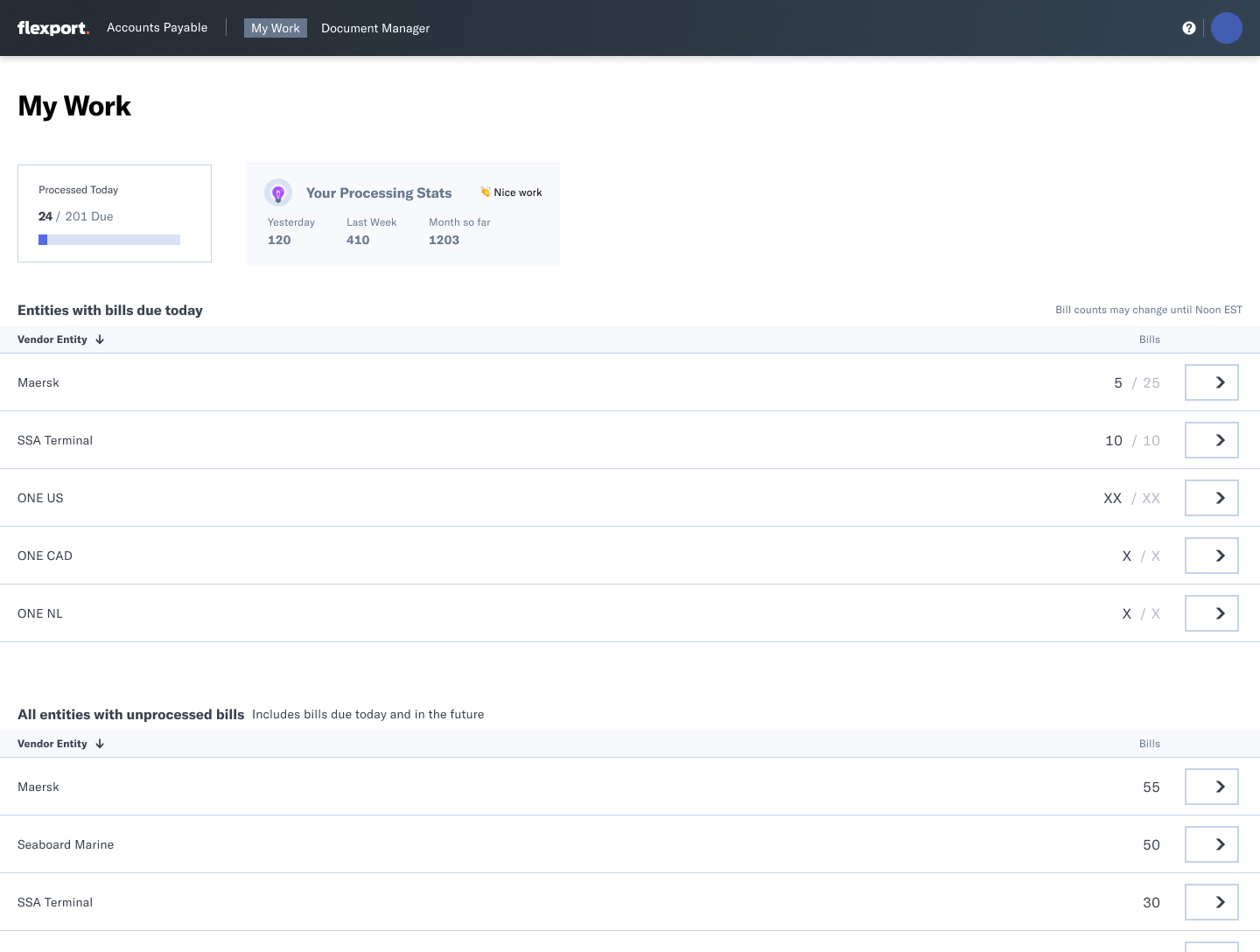Financial Automation for Flexport
[simplify to one line]
PROBLEM
The Accounts Payable manual processes weren’t keeping pace with the growth of the company.
MY ROLE
Led design, research, and workshop facilitation
SOLUTION
Automate work management for bills that required manual processing
IMPACT
$900K annual cost reduction, near 1000% cost prediction accuracy
Team
2 PMs, 8 Engineers, 3 Financial Ops
Problem Context
Flexport is a pre-ipo, global logistics startup. The Accounts Payable (AP) team was at the crux of the business. Flexport worked with a vast array of vendors including ocean carriers, airlines, and trucking companies. Flexport leveraged this network to provide a seamless and competitive shipping experience for customers. AP was key to maintaining relationships with the vendors so that Flexport could provide competitive service offerings.
Unfortunately, the AP team was regularly paying bills late or losing track of bills altogether. Vendors were negotiating worse contract terms and prices as a result.
Additionally, AP was costly. On average, bills cost $3.45 to process, over twice as much as competitors. Not a good look for an IPO.
Flexport’s AP team needed to process bills faster, cheaper, and more accurately. Processing could be partially automated, but the human processes needed to be up-leveled too.
Initial User Research
I conducted remote interviews with the AP Team to better understand their workflow. I reported the learnings that set the trajectory for our team for the next few quarters.
Two key roles were responsible for bill process
Leads were responsible for prioritization and delegation
They relied on a spreadsheet to gather work and assign it to Associates. They would spend north of 90mins a day inputting data into this spreadsheet from a database.
They had no visibility into the Associate’s progress.
Leads desperately needed automated work management.
[update this visual to demonstrate data base to document]
Associates were responsible for processing bills, essentially data entry.
Referencing the Lead’s spreadsheet, they would work out of a database interface.
Findings from UXR Report
I recommended we build a work management product to increase efficiency:
Leads needed automated work management and the ability to monitor the team’s progress.
Associates needed a dedicated work queue to focus and streamline their work
Defining the solution
I led a cross-functional workshop with product, engineering, and financial ops. We needed to align on the problems, requirements, and ruthlessly prioritize.
I led a user empathy and problem statement definition exercises.
I asked the group to react to sketches based on my assumptions to define requirements. This was the meat of the workshop. Our FinOps stakeholders were able to cut through ambiguity and give us clear priority.
[UPDATE THIS VISUAL TO INCLUDE SKETCH]
The Road to MVP
Prototype
Next, I needed to validate our assumptions from the workshop.
The MVP would have 3 screens to provide the basic functionality for work management
Leads
The MVP was to automate the Lead’s assignment task. Assignments would be “set and forget”. This replaced the grueling daily task of gathering counts of bills and assigning associates in a spreadsheet.
Leads could in intervene in assignments when they deemed a user to be overloaded.
The MVP was focused on making sure all the vendors were accounted for. A dedicated Team view for load balancing was planned for V2.
Prototype testing learnings:
Leads found most MVP features useful over the existing manual process
However, they would need at least a basic indicator for team progress
Countering our assumptions, Leads needed the ability to access other teams. We need to design for more flexibility between teams
Associates
The associate streamlined
[finish writing this]
-
-
-
Learnings from Testing
[it did fine for MVP, was lacking features we’d release later]
They wanted to see a count of processed bills so that they could track their progress
Columns needed to be rearranged slightly
MVP Released
Lead Assignments Table
[blurb about this simple table to control automation.
-leaning on existing design patterns for speed to market]
[RECORD PROTOTYPE TO DEMONSTRATE]
Associate Work Queue
[Again, repurposed components for MVP]
MVP Learnings
[Yay success, improved efficiency on first team by almost 40 hours]
[However, challenging to load balance. The scrappy design wasn’t the clearest]
Minimum Loveable Product
Lead Overview Page
[describe how a lead would use this]
[Load balancing is a whole lot easier, info display easier to grasp. Was able to use estimated time on bill from the mvp]
[WILL REPLACE WITH GIF OF PROTOTYPE]
Associate
[Simple, motivating dashboard. Focus on self mastery. Able to leverage existing illustrations and usage data]
[Finally able to revisit the bill processing player. Simplified to a typeform style data entry]
[Should show before - how and when]
Conclusion
The product is on track to save the team over 400 hours worked and reduce the need for 10 additional headcounts in the first year. The estimated cost savings is $2.9m for 2023. As of the MVP launch, on-time bill payment was near 100%, and most carries have removed account holds.
A few learnings I had from this project:
If I was to do this project again, I would start with a concept without constraints and work backward
The MVP Lead interfaces needed more exploration - I had promised too tight of a timeline
I wish I had looked at more analogous interfaces beyond AP software for inspiration
The problem statement exercise did not go well with difficult stakeholders, and I would try brining them options next time




















